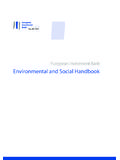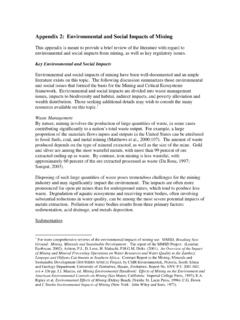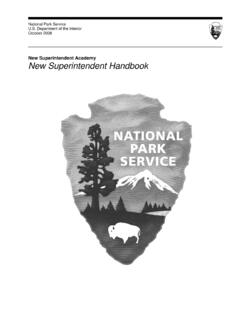Transcription of Handbook for Implementers of ISO 26000, Global …
1 Handbook for Implementers of ISO 26000 , Global Guidance Standard on social Responsibility Designed by ECOLOGIA. for Small and Medium Sized Businesses Version Two May 2011. Note This Handbook has been prepared by ECOLOGIA as an independent project, to encourage adoption and implementation of ISO 26000 . We have based it on the ISO 26000 International Standard, Guidance on social Responsibility, and on all the information available to us as Expert Delegates. ECOLOGIA participated in the ISO 26000 Working Group on social Responsibility (WGSR) for five years, from its first plenary session in 2005 to the final official vote in September 2010. That vote, by National Standards Body participating members, was 93% in favor of adoption of the Final Draft as an ISO International Standard. Its official launch date was November 1, 2010. This Handbook is not in any way intended to replace the entire ISO 26000 document.
2 For more information about ISO and ISO 26000 , see For more information about ECOLOGIA's work in the process of creating this standard, see To purchase the complete official ISO 26000 document (106 pages), you can contact any country's National Standards Body. ISO 26000 is available in many languages. Randy Kritkausky and Carolyn Schmidt, Expert Delegates to ISO 26000 WGSR. Xiaoxue Weng, China CSR Program Specialist ECOLOGIA Tel. +1-802-623-8075. PO Box 268, Middlebury Vermont 05753 USA. E-mail: Website: Copyright 2010, 2011 ECOLOGIA. Use and Licensing Information ECOLOGIA has obtained a license for this Handbook , through Creative Commons ( ). This material is copyrighted by ECOLOGIA. You are free to share to copy, distribute and transmit this Handbook under the following conditions: Attribution: you must attribute this Handbook to ECOLOGIA, including our name and website address. ( ). Non-Commercial: you may not use this work for commercial purposes.
3 That is, you may not sell it, nor sell your services to work with Implementers using it. No Derivatives You may not alter, transform or build upon this Handbook . Waiver Any of these conditions can be waived (set aside) if you get permission from ECOLOGIA. Please contact us with any requests. Handbook for Implementers of ISO 26000 , Version Two, by ECOLOGIA. is licensed under a Creative Commons Attribution-NonCommercial-NoDerivs Unported License. Handbook for Implementers of ISO 26000 . Contents Preface .. 3. Part I: Introduction .. 3. What is ISO 26000 and who is it for?..3. What opportunities does ISO 26000 provide for its Implementers ?..4. How does ISO 26000 encourage sustainable development? .. 4. Key Elements of ISO 26000 ..5. Part II: Implementation Workbook ..7. 1. Your Current Picture .. 9. 2. Evaluation for Each of the Seven Core Subjects . 10. Table 1 Importance of core subjects for our business.
4 10. Table 2 CSR programs and activities already established in our business ..11. 3. Engaging Your Stakeholders ..13. Table 3 Stakeholder and core subject worksheet ..15. 4. Plans for Improvement ..19. 5. Public Reporting ..21. 6. How to Claim Credit for Your Use of ISO 26000 ..23. Part III: The Seven Core Subjects: Definitions, Principles and Action Suggestions .27. Organizational governance.. 27. Human rights .. 27. Labor practices .. 29. Environment .. 30. Fair operating practices ..31. Consumer issues ..31. Community involvement and development ..32. 1. Handbook for Implementers of ISO 26000 . 2. Handbook for Implementers of ISO 26000 . PREFACE. ECOLOGIA's Handbook for Implementers of ISO 26000 is designed for use by small and medium sized businesses. By using this international standard's approach to Corporate social Responsibility (CSR), businesses can improve their impact on their communities and increase their competitiveness.
5 ISO 26000 carries within it the high hopes and expectations of its creators and of future generations who depend on us to pass on the natural, social and economic resources that we have inherited or created. PART I: INTRODUCTION. I SO 26000 is a voluntary guidance standard on social responsibility designed for use by any organization. It can be used by business leaders to plan and implement actions to improve their sustainability economically, socially, and environmentally. This Handbook aims to deepen businesses' understanding of ISO 26000 , and to assist them in adopting the standard into their core business decisions. This Handbook is divided into three parts: 3. Summary of core 1. Introduction: subjects: 2. Implementation information on key workbook definitions, principles &. elements of ISO 26000 . action suggestions What is ISO 26000 , and who is it for? or many successful businesspeople and perhaps for you - being socially responsible is a F part of who they are and why they are in business: to provide useful products and services, to provide jobs and development opportunities for their communities, and to gain satisfaction through meaningful work.
6 In many countries, these socially responsible entrepreneurs have been quietly making a difference by acting on their values and principles, and inspiring others. They have the spirit of social responsibility already. However, in many sectors and many parts of the world, people and businesses still lack the spirit or understanding of being responsible. They may lack the knowledge or incentive to realize that their actions are important for the well-being of other people and the environment. ISO 26000 is a response to the urgent need for all people, from all parts of the world, to have a positive impact on those around them, through the way they do business and live their lives. I SO 26000 provides broad guidance, but does not offer specific instructions or require specific outcomes. Businesses that implement ISO 26000 have opportunities to identify and act on their own priorities, and to build stronger business models in the spirit of continuous improvement.
7 Implementers of ISO 26000 will develop their unique corporate social responsibility programs and become models for others. 3. Handbook for Implementers of ISO 26000 . ISO 26000 was created by a diverse group of experts, representing many different countries, 1. stakeholder groups , and points of view. Work began in 2005 and was completed in 2010. Creation of the standard was organized by the International Standardization Organization, ISO, based in Geneva Switzerland. Since 1947 ISO has developed over 17,000 standards to encourage world trade and quality production. Previous well-known ISO standards include ISO 9000. (quality control) and ISO 14000 (environmental management systems). Unlike ISO 9000 and 14000, however, ISO 26000 is a voluntary guidance standard and is not intended for certification. What opportunities does ISO 26000 provide for its Implementers ? ECOLOGIA has prepared this Handbook especially for small and medium sized businesses.
8 Using this Handbook will assist you in identifying ways that you can strengthen the local, regional, or Global communities upon which you depend. You can thereby create stronger and more enduring partnerships with your investors, customers, workers, suppliers, and community members. This Handbook will assist you in reporting on your business's strengths and contributions. It can also alert you to problem areas or blind spots previously neglected in your management and planning. By encouraging communications with stakeholders, ISO 26000 will help you to gather useful information beyond the limits of your current resources. For example, You may identify new products, services or By adopting ISO 26000 into your manufacturing processes;. core business model, you can You may generate more effective promotion and identify paths to innovation marketing plans, focusing on the value-added social reduce long-term risks responsibility components of your business.
9 Increase your By reporting on your current situation in each of the core competitiveness subject areas, you can earn trust and establish yourself as a business which is committed to social responsibility. How does ISO 26000 encourage sustainable development? Sustainable development is growth and change that maintains and improves the natural environment, human resources, and society upon which we depend. Businesses that identify, It is designed to be maintain, and improve their natural and human resources are flexible, and to provide highly competitive. They are more able to cope with leaders with guidelines challenges in the marketplace. They can anticipate and reduce and choices. threats caused by environmental changes or natural disasters, and can better adapt to significant social changes. No business can predict the future perfectly; but smart businesses can plan for a future in which significant social and environmental changes occur.
10 Businesses that contribute to a more sustainable society are more likely to be valued and supported by consumers, supply chains, and policy makers. ISO. 26000 provides information and decision-making tools for businesses to identify ways they can improve their impacts on the people and places they work and live in, and thereby become more valuable and valued members of society. 1. The Working Group on social Responsibility (WGSR) that created ISO 26000 included six stakeholder groups: industry, government, labor, NGO, consumer, and SSRO (service, support, research and others). 4. Handbook for Implementers of ISO 26000 . Key Elements of ISO 26000 : Stakeholders, Core Subjects and Reporting 1) Stakeholders are those people and groups that are affected by the actions of your business. These can include workers, suppliers, community residents, consumers, and investors. Communicating with them is one of the best ways a business can find out where it is doing a good job, and where it could improve.




